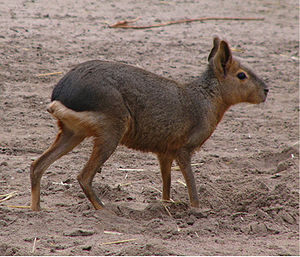Pampas hares
| Pampas hares | ||||||||||||
|---|---|---|---|---|---|---|---|---|---|---|---|---|

Great pampas hare ( Dolichotis patagonum ) |
||||||||||||
| Systematics | ||||||||||||
|
||||||||||||
| Scientific name of the subfamily | ||||||||||||
| Dolichotinae | ||||||||||||
| Pocock , 1922 | ||||||||||||
| Scientific name of the genus | ||||||||||||
| Dolichotis | ||||||||||||
| Desmarest , 1820 |
The pampas hares or maras (Dolichotinae) form a subfamily of the guinea pigs in the order of rodents . There is only one genus ( Dolichotis ) with the two species : Actual or Large Pampashase / Mara ( D. patagonum ) and Small Pampashase / Mara ( D. salinicola ).
features
The top and bottom of the fur are sharply defined at the rear end: white below, gray-black above. The small pampas hare is about 30 cm smaller than the large pampas hare, which can reach a head-trunk length of 65-81 cm and a tail length of about 5 cm. The females of the large maras reach an average weight of 8.3 kg, the males on the other hand only 7.7 kg. The maximum weight of the animals is 16 kg. Sitting the animal is reminiscent of a hare, but when standing it looks like a small hoofed animal.
distribution
Both species live in South America. The large pampashase inhabits the large grassy plains of the pampas of Argentina , the small pampashase, on the other hand, lives in the dry areas of the Gran Chaco in northern Argentina, the extreme south of Bolivia and in Paraguay . The animals inhabit grass steppes or forests, where they can always seek cover from enemies.
Way of life
The pampas only change their partner when the latter dies. The female is able to mate every three to four months and is only able to conceive for half an hour. It throws once a year, which falls on the months of August to November. The Mara females can give birth to a maximum of five young; the gestation period is about 90 days. The animals have a life expectancy of around 10 to 15 years.
Natural enemies include pumas , other cats , grisons, and foxes . Birds of prey can only be life-threatening for the young. Due to the destruction of their natural habitat, the number of maras living in the wild is falling sharply. They have been classified as low risk by the International Union for the Conservation of Nature and Natural Resources (IUCN) .
Web links
Individual evidence
- ↑ Animal of the month January: Mara / Pampashase. In: Latin America Journal. January 2, 2013, archived from the original on January 12, 2013 ; accessed on November 24, 2018 .
- ↑ Dolichotis patagonum in the IUCN Red List of Threatened Species 2011.2. Posted by: R. Ojeda, U. Pardinas, 2008. Retrieved March 5, 2012.
- ↑ Dolichotis salinicola in the IUCN Red List of Threatened Species 2011.2. Listed by: J. Dunnum, J. Vargas, N. Bernal, U. Pardinas, R. Ojeda, 2008. Retrieved March 5, 2012.
